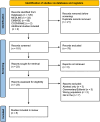Concomitant sacroiliac joint abnormalities in patients with femoroacetabular impingement
- PMID: 40156722
- PMCID: PMC12283877
- DOI: 10.1007/s00264-025-06484-6
Concomitant sacroiliac joint abnormalities in patients with femoroacetabular impingement
Abstract
Purpose: Despite the increasing understanding of femoroacetabular impingement (FAI), the impact of specific patient characteristics, including inflammatory pathologies like axial spondyloarthritis (axSpA), on its pathophysiology and clinical outcomes following treatment remains inadequately defined. Therefore, the purpose of this scoping review was to evaluate the relationship between FAI and sacroiliac (SI) joint abnormalities and FAI and axSpA.
Methods: The study was conducted following the framework established by Arksey and O'Malley and Levac et al., adhering to the PRISMA scoping review extension checklist. A systematic search was performed across MEDLINE, EMBASE, and Cochrane Library databases for articles published until August 2024. A total of 120 articles were screened and eight finally met the inclusion criteria.
Results: The review analysed data from the eight retrospective studies with a total of 1,723 patients. We found that the prevalence of SI joint abnormalities in patients with FAI can be as high as 25-28%. Furthermore, the prevalence of FAI morphology in patients with axial spondyloarthritis can be as high as 20-37%. Finally, patients undergoing hip arthroscopy for FAI with axSpA and/or SI joint abnormalities have lower postoperative outcome scores reported in comparison with those patients who do not have these comorbidities.
Conclusion: Over a quarter of patients with FAI can have concomitant radiographic SI joint abnormalities. We cannot overemphasise the importance of assessing the spine, specifically the SI joint, and ruling out symptoms emanating from the SI joint in all patients with FAI. There is clearly a knowledge gap in understanding the underlying pathophysiology linking FAI and axSpA. We require further research to elucidate the underlying mechanisms of this relationship, standardise evaluation methods, and explore long-term outcomes in this cohort of patients.
Keywords: Axial spondyloarthritis; Femoroacetabular impingement; Sacroiliac joint; Scoping review.
© 2025. The Author(s).
Conflict of interest statement
Declarations. Human ethics and consent to participate: Not applicable. Competing interests: President of SICOT Educational Consultant Smith and Nephew Board Member BOA, ISHA, EHPA Associate Editor and Chief JISAKOS.
Figures



Similar articles
-
Surgical Hip Dislocation in the Era of Hip Arthroscopy Demonstrates High Survivorship and Improvements in Patient-reported Outcomes for Complex Femoroacetabular Impingement.Clin Orthop Relat Res. 2024 Sep 1;482(9):1671-1682. doi: 10.1097/CORR.0000000000003032. Epub 2024 Mar 21. Clin Orthop Relat Res. 2024. PMID: 38513108
-
Mini-open Femoroacetabular Osteoplasty in Patients With Tönnis Grade 2 or Higher Osteoarthritis is Associated With a Higher Risk of Subsequent Conversion to THA.Clin Orthop Relat Res. 2024 Sep 1;482(9):1614-1623. doi: 10.1097/CORR.0000000000002944. Epub 2024 Jan 3. Clin Orthop Relat Res. 2024. PMID: 38170724
-
Hip-Spine Relationship in Femoroacetabular Impingement: Does Hip Arthroscopy Affect Pelvic Mobility?Clin Orthop Relat Res. 2025 May 1;483(5):846-852. doi: 10.1097/CORR.0000000000003348. Epub 2024 Dec 17. Clin Orthop Relat Res. 2025. PMID: 39787405
-
Over 50% of Studies Report Low-Back Pain Is Associated With Worse Outcomes After Hip Arthroscopy When Compared With a Control Group: A Systematic Review.Arthroscopy. 2023 Dec;39(12):2547-2567. doi: 10.1016/j.arthro.2023.05.004. Epub 2023 May 18. Arthroscopy. 2023. PMID: 37207922
-
Bilateral hip arthroscopy for treating femoroacetabular impingement: a systematic review.Knee Surg Sports Traumatol Arthrosc. 2022 Mar;30(3):1095-1108. doi: 10.1007/s00167-021-06647-z. Epub 2021 Jun 24. Knee Surg Sports Traumatol Arthrosc. 2022. PMID: 34165631
References
-
- Colvin AC, Harrast J, Harner C (2012) Trends in hip arthroscopy. JBJS 94:e23. 10.2106/JBJS.J.01886 - PubMed
-
- Montgomery SR, Ngo SS, Hobson T et al (2013) Trends and demographics in hip arthroscopy in the united States. Arthroscopy 29:661–665. 10.1016/j.arthro.2012.11.005 - PubMed
-
- Ganz R, Parvizi J, Beck M et al (2003) Femoroacetabular impingement: A cause for osteoarthritis of the hip. Clin Orthop Relat Research® 417:112. 10.1097/01.blo.0000096804.78689.c2 - PubMed
-
- Agricola R, Heijboer MP, Bierma-Zeinstra SMA et al (2013) Cam impingement causes osteoarthritis of the hip: a nationwide prospective cohort study (CHECK). Ann Rheum Dis 72:918–923. 10.1136/annrheumdis-2012-201643 - PubMed
Publication types
MeSH terms
LinkOut - more resources
Full Text Sources
Miscellaneous

